Introduction
Stunting, a sign of chronic malnutrition, is a delay in the linear developmental and cumulative growth deficit in children. If a child’s height-for-age Z-score (HAZ) is two or more standard deviations (SD) below the median of the international gender-specific reference group, he or she is deemed stunted.1 Stunting, as one of the most prevalent signs of undernutrition in the world, has a global prevalence of about 22% (151 million) among children under the age of five. About 66% of stunted children are in low- and middle-income countries.2 In Egypt, several school-based cross-sectional studies reported the prevalence of stunting among primary school children in different governorates.3-5
Stunting is not only one of the burdens of chronic hunger, but also hidden hunger or lack of micronutrients, whether vitamins or minerals, especially zinc.6 The problem of stunting in children is not only the external appearance in terms of short stature, but it has also been found that stunting is associated with a decrease in the physical and cognitive abilities in addition to its association with the lack of immune strength of the child for life.7
A Hypo-protein diet was used in several studies to develop malnourished rats in which growth and metabolism can be studied.8-10 Animal source foods (ASF), including egg, dairy product, milk, meat, and fish, outperform plant-based foods not only in terms of protein quality but also in terms of content and bioavailability of nutrients such as vitamins, minerals, folic acid, essential fatty acids, and essential amino acids. ASF is more efficient in reducing malnutrition than individual synthetic dietary supplements, especially when these supplements are difficult to obtain or not taken regularly.11 Therefore, the authors hypothesized that a food product containing some foods of animal origin along with some other nutritious foods, such as wheat germ and carrots, may be useful in preventing stunting caused by malnutrition. This study aimed to assess the organoleptic, physical, and chemical properties of crackers made from nutritional ingredients and various animal source foods. The study also intended to test the crackers in malnourished rats to see if they were feasible before testing them in schoolchildren.
Material and Methods
Figure 1 illustrates the schematic presentation of the study design (four steps). First, four samples of crackers with different tastes (cumin, paprika, tomato, and cheese) were prepared from nutritious ingredients along with foods from animal origin for the nutritional recovery of humans. Second, organoleptic and physical properties, antioxidant activity, total phenolic contents, and total flavonoid contents of the crackers’ samples were determined. Third, the cumin-flavored crackers were evaluated for their macro-and micronutrients. Fourth, the cumin-flavored crackers were evaluated in malnourished rats.
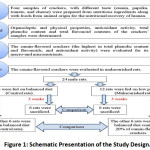 |
Figure 1: Schematic Presentation of the Study Design. |
Materials
Raw Materials and Chemicals
Carrot, wheat germ, butter, full cream yogurt, egg, dry yeast, iodine salt, full cream white cheese, cumin, paprika, cheese powder, tomato powder, and wheat flour (72% extraction) were obtained in Cairo, Egypt, at a local market. The chemicals and reagents utilized in this work were all of the analytical grades.
Methods
Preparation of the Crackers’ Samples
All ingredients (35g of wheat flour, 8g of minced fresh carrot, 10g of wheat germ, 14g of egg, 5g of butter, 17g of full cream yogurt, 8g of full cream white cheese, 1g of yeast, and 0.5g of iodine salt) were mixed with adding 1.5g of different flavor powder samples (cumin, paprika, cheese or tomato powder). Thus, 4 samples of crackers, with different tastes, were prepared. On a floured surface, the dough was kneaded very lightly until it was just smooth and divided into a ball, and left to rest for 15 minutes. Each ball was then flattened to 0.1cm thickness and cut into small shapes. The oven was preheated at 150ᵒ C and crackers were baked at 150ᵒ C until well baked.12
Organoleptic Properties of the Crackers’ Samples
Twenty panelists assessed the cracker samples for color, taste, crispness, odor, and appearance using the seven hedonic score system.13 Cracker samples were presented to the panelists in clear plates that were identified with three-digit random codes. Between samples, the panelists were provided with distilled water to rinse their mouths. The samples were shown to the judges in a random order, and they were asked to grade their approval by assigning a score to each parameter.
Antioxidant Activity, Total Phenolic Content and Total Flavonoid Contents of the Crackers’ Samples
Twenty grams of each sample (flavor powders or cracker samples) were immersed in 200 ml of ethanol (70 percent), agitated for 24 hours at room temperature, then centrifuged for 15 minutes at 4000 g. Total phenolic content, total flavonoids content, and radical scavenging properties were assessed in the obtained supernatants. Foline Ciocalteau calorimetric method was used to determine total phenolic content (TPC) using a spectrophotometer at 765 nm.14 Aluminium chloride (AlCl3) colorimetric test was used to determine the total flavonoids content.15 The radical scavenging activity was measured using a stable 2,2-diphenyl-1-picrylhydrazyl (DPPH) free radical.16
Physical Properties of the Crackers’ Samples
Weight, volume, height, diameter, specific volume, and spread factor of the crackers’ samples were determined. The weight was measured using an electronic weighing balance. A vernier caliper (Sakara, electronic digital vernier caliper) was used to measure the diameter and height. Spread ratio = diameter / height. The volume and the specific volume were determined using a method described by Minarovičová et al.17 A texture analyzer, model TA-XT2, and the XTRA Dimension application (Stable Micro Systems, Surrey, England) with the p/25 cylindrical aluminum sensor probe were used to assess the texture of the cracker samples. Test option and mode = compression force measurement, hold till time, pretest speed = 2mm/s, test speed = 2.5 mm/s, posttest speed = 2mm/s, and fixture=TA-SBA were the settings set.
Surface Structural Properties of the Crackers’ Samples
Crackers were observed the surface structure with a Digital microscope (Japanese PDF Instructions) with magnification 1600X. The Digital Microscope was with a USB Connection for Windows (Microsoft Windows) Compatible.
Chemical Analysis of the Cumin-Flavored Crackers
The cumin-flavored crackers samples were chosen for further testing in experimental animals because they scored the highest in terms of total phenolic compounds and flavonoids content, and antioxidant activity. The American Association of Cereal Chemists (AACC) 18 procedures were used to do the proximate analysis (moisture, ash, crude fat, crude fibers, and nitrogen content). By an amino acid analyzer (Biochrom 30) from Germany, amino acids were measured using the Association of Official Analytical Chemists (AOAC) method.19 Minerals (Fe, Zn, Ca, P, K, Cu, and iodine) were measured at 422 nm using Atomic Absorption Spectrometry (PyeUnicm Model 3300, PyeUnicam Ltd. Cambridge, England) according to AOAC protocols. 20 By using the HPLC approach, vitamins (B12 and A) were determined, as described by Vinas et al.21 and Garai22, respectively.
Evaluation of the Cumin-Flavored Crackers in Stunned Rats
Animals
The animal house of the National Research Centre in Cairo, Egypt, furnished 24 male Sprague-Dawley rats (5 – 6 weeks old) weighing 123.4 ± 7.67 g (as mean ± SD). Individually housed in stainless steel cages, the animals were kept in conventional laboratory settings (23–25 °C, 12 h light/dark cycle) with free access to food and water. This research was carried out in accordance with the Medical Research Ethics Committee of the National Research Centre in Cairo, Egypt, and followed the directions of the National Institutes of Health Guide for the Care and Use of Laboratory Animals (Publication No. 85-23, revised 1985).
Animals’ Diets
A balanced diet with 12 % casein, 10% corn oil, 10% sucrose, 58.5 % maize starch, 5% fiber, 3.5 percent AIN-93M salt mixture, and 1% AIN-93M vitamin mixture was prepared.23 A low-protein isocaloric diet was prepared with 6% protein9 (casein), 10% corn oil, 10% sucrose, 64.5 % maize starch, 5% fibre, 3.5 percent AIN-93M salt mixture, and 1% AIN-93M vitamin mixture. A diet containing nutrient-rich crackers contained the same components as the protein-deficient diet, with the addition of 20% cumin-flavored crackers. The amount of protein, fat, crude fiber and carbohydrates contained in 20 of the cumin-flavored crackers were deducted from casein, oil, cellulose and starch, respectively.
Animals’ Study Design
After one week of acclimation, twelve rats were employed as the control group and fed a balanced diet, whereas the other twelve rats were malnourished by feeding a protein-deficient diet to induce stunting. After 3 weeks of feeding, 6 rats from each group (control and malnourished groups) were measured for length and weight and then sacrificed, after blood withdrawing, to examine the bone minerals, bone length, and the other parameters after the malnutrition period. Dietary intervention (for 5 another weeks) was carried out for the remaining malnourished rats by feeding on the diet supplemented with 20% of the cumin-flavored crackers. After the dietary intervention period, all rats were measured for length and weight then, sacrificed after blood withdrawal. Food intake was recorded daily. After the malnutrition period or the nutritional intervention period, body weight gains, as well as the food efficiency ratio, were calculated.
Blood and Tissues Analysis
After an overnight fast, blood samples were taken from all rats. Serum was analyzed for concentrations of insulin-like growth factor-I (IGF-I), cluster of differentiation 4 (CD4), and a cluster of differentiation 8 (CD8), using rats IGF-I, CD4, and CD8 enzyme-linked immunosorbent assay kits (Sunlong Biotech, China) in compliance with the instructions provided by the manufacturer. CD4-CD8 ratio was calculated. CD4-CD8 ratio refers to the ratio between “helper” CD4 T-cells to “killer” CD8 T-cells.24 Serum calcium, magnesium, zinc, and iron were determined according to Gindler and King25, Smith26, Makino et al.27, and Stookey28, respectively. Serum creatinine, urea, total protein, albumin, and bilirubin were determined as described by Larsen29, Fawcett and Scott30, Rheinhold31, Doumas et al.32, and Jendrassik and Grof33, respectively. Globulin and albumin/Globulin (A/G ratio) were calculated. The activities of aspartate transaminase (AST) and alanine transaminase (ALT), as well as alkaline phosphatase (ALP), were determined according to Reitman and Frankel.34 and Bessey et al.35 Rats were dissected after blood sample, and the liver, kidney, and femur of each rat were promptly separated and weighed. Total lipids in the liver were assessed according to Folch et al.36 and Cequier-Sánchez et al.37 Femur of each rat was measured for its length, then burned at 600º C using muffle to be transformed into ash, which was then employed in the atomic absorption spectrophotometer apparatus (model IL atomic absorption/air ethylene) to estimate calcium and magnesium.
Statistical Analysis
The results of the crackers’ samples’ organoleptic, physical, and antioxidant properties, as well as the total phenols and total flavonoid contents, were conveyed as mean ± SD and statistically analyzed using SPSS statistical package (Version 20.0) analysis of variance (ANOVA) then Duncan’s multiple range test. The animal experiment’s results were graphed as mean ± SE and statistically assessed using GraphPad Prism version 7.01 (San Diego, California) by Student’s t-test or nonparametric Mann-Whitney test according to the characteristics of each variable. The statistical significance criteria were always set at p≤0.05.
Results
Photographs of the crackers’ samples are presented in Figure 2. As shown in Table 1, all crackers’ samples (cumin, paprika, cheese, and tomato) recorded acceptability by values 8.44, 8.22, 8.22, and 8.33, respectively. Cumin-flavored crackers had the highest acceptability value.
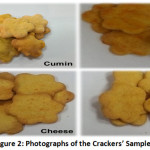 |
Figure 2: Photographs of the Crackers’ Samples. |
Table 1: Organoleptic Properties of the Crackers’ Samples (Mean ± SD)
| Crackers’ sample | Appearance | Aroma | Crispness | Taste | Color | Overall acceptability |
| Cumin | 7.89±1.36 | 9.00a±0.01 | 7.67±1.22 | 9.11a±0.33 | 8.28±0.97 | 8.44±0.73 |
| Paprika | 8.89±0.93 | 8.33ab±0.87 | 8.33±0.71 | 7.78b±1.09 | 8.44±0.73 | 8.22±0.83 |
| cheese | 8.44±1.13 | 8.83a±0.50 | 8.06±0.81 | 8.39ab±0.99 | 8.11±0.78 | 8.22±0.67 |
| Tomato | 8.44±1.01 | 8.00b±0.87 | 7.89±1.24 | 8.89a±0.33 | 8.11±0.93 | 8.33±0.87 |
In each column, different superscripts indicate significant differences. ab and b significantly (p < 0.05) are less than a.
As noticed from Table 2, all flavors powder (cumin, paprika, cheese, and tomato), as well as all crackers’ samples, exhibited antioxidant activity. However, cumin powder had the significantly highest values of TPC (233.18 mg/100g), flavonoid (24.33 mg/g), and antioxidant activity (70.99 %). Likewise, cumin-flavored crackers had the significantly highest values of total phenols (89.99 mg/100g), flavonoid (7.63 mg/g), and antioxidant activity (31.24%).
Table 2: Antioxidant Activity (DPPH) Radical %, Total Flavonoids (mg/g), and Total Phenolic (mg/100g), of Flavors Powder and Crackers’ Samples (Mean ± SD)
| DPPH % of flavors |
DPPH % of crackers |
Total flavonoids of flavors |
Total flavonoids of crackers |
Total phenolic of flavors |
Total phenolic of crackers |
|
| Cumin | 70.99a±0.50 | 31.24a±0.80 | 24.33a±0.39 | 7.63a±0.17 | 233.18a±5.65 | 89.99a±0.20 |
| Paprika | 62.29d±0.49 | 18.94d±0.97 | 10.94b±0.27 | 4.46b±0.33 | 75.50c±1.03 | 31.75b±0.18 |
| Cheese | 66.19b±0.87 | 27.45b±0.24 | 2.36d±0.11 | 1.03d±0.02 | 74.84c±1.00 | 24.59d±0.34 |
| Tomato | 64.77c±0.07 | 24.62c±0.32 | 8.83c±0.04 | 3.56c±0.44 | 83.71b±0.73 | 25.89c±0.39 |
In each column, different superscripts indicate significant differences. b, c, and d significantly (p < 0.05) less than a.
The physical properties of the crackers’ samples were summarized in Table 3. The hardness and fracture-ability of all crackers’ samples were almost the same.
Table 3: Physical Properties of the Crackers’ Samples (Mean ± SD)
| Properties | Cumin | Paprika | Cheese | Tomato |
| Weight (g) * | 30.33b±0.28 | 31.27a±0.42 | 30.51b±0.33 | 31.73a±0.09 |
| Volume (cm3) ** | 36.06b±0.18 | 33.76c±0.10 | 37.37a±0.17 | 33.79c±0.19 |
| Height (mm) | 6.74a±0.15 | 6.16b±0.38 | 6.55ab±0.27 | 6.58ab±0.26 |
| Diameter(mm) | 33.91a±0.20 | 34.36a±0.34 | 34.00a±0.58 | 34.05a±0.23 |
| Specific volume (cm3/g) | 1.19b±0.01 | 1.08c±0.01 | 1.23a±0.01 | 1.06c±0.01 |
| Spread factor | 5.03b±0.11 | 5.59a±0.34 | 5.20b±0.18 | 5.18b±0.22 |
| Hardness(N) | 59.13 | 58.57 | 57.78 | 60.35 |
| Fracture-ability(N) | 59.13 | 58.57 | 57.78 | 60.35 |
*Stack of 15 crackers; **average value in a stack of 15 crackers; In each row, different superscripts indicate significant difference. b, ab and c significantly (p < 0.05) less than a.
Surface structure images of the crackers’ samples (Figure 3) show differences in the surface structure among the crackers’ samples. Paprika and cheese-flavors crackers looked like they had continuous aggregation with few fissures on the surface of the cracker, while the cumin and tomato-flavors crackers had smoother surfaces with reduced or no aggregation.
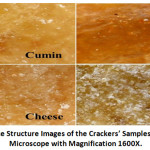 |
Figure 3: Surface Structure Images of the Crackers’ Samples Under a Digital Microscope with Magnification 1600X. |
The results of the chemical analysis of the cumin-flavored cracker are summarized in Table 4.
Table 4: Macro and Micro-Nutrients of the Cumin-Flavored Crackers (100g).
| Calories (Kcals) | 339.94 |
| Protein (g) | 15.64 |
| Fat (g) | 10.14 |
| Crude fiber (g) | 13.50 |
| Ash (g) | 4.19 |
| Carbohydrates (g) | 46.53 |
| Moisture (%) | 10.00 |
| Calcium (mg) | 231.00 |
| Iron (mg) | 8.34 |
| Magnesium (mg) | 75.15 |
| Zinc (mg) | 4.00 |
| Iodine (µg) | 83.75 |
| Vitamin A (µg) | 359.00 |
| Arginine (mg/g protein) | 16.53 |
| Lysine (mg/g protein) | 19.30 |
As noted from Figure 4, after the low protein diet time, the malnourished rats showed significantly lower weight gain, food efficiency ratio, and liver weight than their controls. After feeding on the nutrients rich-crackers, the malnourished rats regained their weight. Also, the food efficiency ratio and the weight of both liver and kidney of rats fed on the nutrients rich-crackers were non-significantly different from those of control rats.
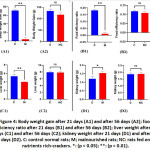 |
Figure 4: |
As noted from Figure 5, after the low protein diet time, the malnourished rats showed significantly lower length, femur weight, and femur length than control rats. The urine volume of the malnourished rats was significantly higher than the normal rats. Rats fed on the nutrients rich-crackers showed no significant differences in length, femur weight, femur length, and urine volume than the normal rats.
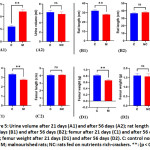 |
Figure 5: |
As inferred from Figure 6, after the low protein diet time, the malnourished rats showed significantly lower serum calcium, magnesium, zinc, and iron than the control rats. After feeding on the nutrients rich-crackers, the malnourished rats showed no significant differences in serum calcium, magnesium, zinc, and iron than control rats. Similarly, femur calcium and magnesium in the malnourished rats were significantly lower than in control rats. After feeding on the nutrients rich-crackers, the malnourished rats showed no significant differences in femur calcium and magnesium than control rats.
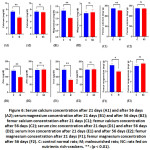 |
Figure 6: |
Figure 7 indicated that after the low protein diet time, the malnourished rats showed significantly lower AST, ALT, and ALP than the control rats. Total bilirubin, direct bilirubin, and total lipids in the liver of the malnourished rats were significantly higher than the control rats. After feeding on the nutrients rich-crackers, the malnourished rats showed no significant differences in AST, ALT, ALP, total and direct bilirubin than control rats. Total lipids in the liver of rats fed on the nutrients rich-crackers were significantly less than that of control rats.
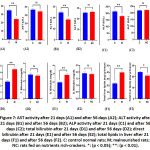 |
Figure 7: |
As shown in Figure 8, after the low protein diet time, the malnourished rats showed significantly lower serum urea, creatinine, total protein, albumin, and globulin than control rats. The A/G ratio of the malnourished rats was significantly higher than control rats. After feeding on the nutrients rich-crackers, the malnourished rats showed no significant differences in serum urea, creatinine, total protein, albumin, globulin, and A/G ratio than control rats.
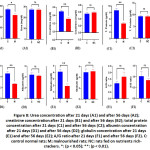 |
Figure 8: |
After the low protein diet time, the malnourished rats showed significantly lower CD4, CD4/CD8 ratio, and IGF-1 than control rats (Figure 9). However, CD8 of the malnourished rats was non-significantly different from that of control rats. After feeding on the nutrients rich-crackers, the malnourished rats showed no significant differences in CD4, CD8, and CD4/CD8 ratio of rats fed on the nutrients rich-crackers than control rats. It is worth noting that IGF-1 of rats fed on the nutrients rich-crackers was significantly higher than in control rats.
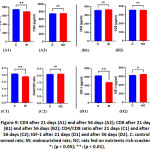 |
Figure 9: |
Discussion
This study aimed to assess the organoleptic, physical, and chemical properties of crackers made from nutritional ingredients (wheat flour, wheat germ, carrot, yeast, and iodine salt) and various animal source foods (egg, butter, full cream yogurt, and full cream white cheese). The study also aimed to test the crackers in stunted rats to see if they were feasible before evaluating them in school children. Dry crackers were chosen because they are not only good and inexpensive functional ingredients, but they are also appealing and can be stored for a long time. In addition to the crunchy texture resulting from not allowing the gluten to expand and increasing elasticity during kneading.12 Sutharut and Sudarat38 reported that commercial crackers, due to their high content of fat, sugar, or salt, can cause several health problems, including dental caries, obesity, diabetes, coronary heart diseases, and hypercholesterolemia. Therefore, we formulated crackers from nutritious components. Despite all the crackers’ samples (cumin, paprika, cheese, and tomato) recorded sensuous acceptance, cumin-flavored crackers had the highest acceptable value, possibly because of cumin that contains aromatic oils, which give it a pleasant flavor in addition to its ability to improve taste and palatability.39
The results showed a significant increase in TPC, flavonoids, and antioxidant power in the powdered cumin over the remaining used flavorings, which explains the significant increase in the aforementioned values of the cumin-flavored crackers. The phenolic compounds, flavonoids, and the antioxidant power of the crackers’ samples can not only be traced back to the added flavorings but also to the components of these crackers, especially wheat germ and carrots. Zou et al.40 reported that wheat germ contains phenolic acids (ferulic, chlorogenic, and caffeic acid) and has antioxidant activity, which increased by the roasting may be due to the production of Millard reaction products. Ahmad et al.41 reported that carrots contain several phytochemicals, including phenolics, carotenoids, polyacetylenes, and ascorbic acid, which provide carrots with antioxidant activity.
According to the results, the cumin-flavored cracker included macro and micronutrients (protein, fat, calcium, iron, zinc, iodine, and magnesium), which might be attributed to the nutritious components and different animal source foods. Egg, wheat germ, carrots, and dairy products (butter, yogurt, and white cheese) are multi-nutrient sources as each ingredient is a rich source of most macro and micro-nutrients.40-43
According to NutriSurvey software (version, 2007), 100g of the cumin-flavored crackers provide 18% protein, 33% vitamin A, 11% calcium, 52% phosphorus, 32% iron, and 54% zinc from the recommended dietary allowance for children aged 4-6 years and provide 18% protein, 29% vitamin A, 9% calcium, 39% phosphorus, 29% iron, and 39% zinc from the recommended dietary allowance for children aged 7-9 years. Thus cumin-flavored crackers may be useful in improving malnutrition in children.
Although the product was intended to be a functional food for primary school children at the age at which stunting occurs, the authors resorted to testing the prepared crackers first on stunted rats after a period of feeding on a low-protein diet in order to first verify the feasibility of the prepared crackers for reducing stunting caused by malnutrition, Also, rats’ nutrition may be controlled to a greater extent. So, more accurate indicators can be obtained. Rats attain sexual maturity at 50 days, whereas children reach sexual maturity at 11.5 years 44, hence rats aged 5-6 weeks were chosen to match the age of primary school students. It has been proven that a low-protein diet causes growth retardation and metabolic abnormalities in animals.9 In our study, rats fed on a protein-deficient diet showed stunted growth, which was evident in many measures, including weight gain, which was taken in many studies as an indicator of normal growth and development. Additionally, rats fed on a protein-deficient diet showed a significant decrease in the length as well as the femur length. An indication of the occurrence of stunting in rats is a significant decrease in insulin growth factor-1, which is the necessary growth hormone for longitudinal bone growth as it stimulates osteocyte proliferation and differentiation. Salameh et al.45 and Bergmans et al.10 found that a hypo-protein diet resulted in stunting and growth retardation in mice. Eyzaguirre-Velásquez et al.46 found that, unlike a balanced diet, 20-days of feeding on a low protein diet failed to produce body weight gain in rats. Protein adequate and quality in addition to sufficient amounts of macro-and micronutrients and energy may be beyond the efficacy of our nutrient-rich crackers reversing the stunting and growth retardation. Also, amino acids content, especially arginine and lysine, might contribute to the enhancement of stunting. These amino acids are recognized to play a direct role in the development of the body. Arginine is also linked to the secretion of growth hormone (GH).47
The decrease in calcium, magnesium, iron, and zinc in the rats’ serum, as well as the decrease in calcium and magnesium in the femur after the low protein diet time, can be attributed to the deficiency of protein, which was proven in some previous studies. Eyzaguirre-Velásquez et al.46 found that, unlike a balanced diet, 20-days of feeding on a low protein diet significantly decreased plasma zinc concentration in rats. The decreased zinc concentration subsequent to feeding on a low protein diet may be also contributed to the reduction in IGF-1 as reported by Roughead and Lukaski.48 Yang et al.49 found that three weeks of feeding on a low-protein diet (3%) led to a reduction of bone minerals, femur length, and insulin growth factor-1 in mice.
In our results, kidney and liver functions were disrupted after the low protein diet time. This can be attributed to protein malnutrition and related reduction in zinc. Zinc deficiency is associated with ROS production as zinc inhibits oxidative stress and activates apoptosis.50 Thus; low zinc concentration may cause increased ROS production, which may be responsible for liver and kidney dysfunction in malnourished rats. The cracker’s content of zinc, phenolic compounds, and flavonoids may be responsible for resetting the kidney and liver functions as a result of the ability of these bioactive compounds to fight free radicals, in addition to the antioxidant capacity of the crackers, which was evident through our results. Lipid accumulation in the liver and hypoalbuminemia were observed in rats after the malnutrition period. Decreased albumin and increased liver fat content are measures that indicate deterioration in the nutritional status associated with feeding on a low-protein diet.51,52 In young Wister rats, dietary protein shortage and amino acid imbalance generate considerable hepatic triglyceride (TG) buildup.53 Campisano et al.54 reported that not only over-nutrition but also under-nutrition mediates metabolic modulations during the developmental period of life. This nutritional imbalance causes epigenetic dysregulation which consequently leads to the development of the non-alcoholic fatty liver. In addition to the contribution of the prepared crackers to restoring the nutritional balance, the fiber content of these crackers (13.5 %) might play a key role in reducing the accumulated fat in the liver, as it is known that fiber plays a major role in reducing the accumulated fat in the liver.55
The protein-deficient diet also reduced the concentration of CD4 as well as the CD4/CD8 ratio. This indicates that feeding on the protein-deficient diet suppressed immunity. Rajamanickam et al.56 reported that immunity is strongly interlinked to nutrition and the CD4/CD8 ratio is decreased subsequently to malnutrition. Yang et al.49 also found that three weeks of feeding on a low-protein diet (3%) led to a reduction in IL-6 and impairment of immunity functions in mice. Additionally, the decreased zinc concentration subsequent to feeding on a low-protein diet may be also contributed to the immunosuppression as confirmed by Domingo and Marquès57 who reported that zinc is one of the essential elements associated with strong immunity and its deficiency causes impairment of immunity functions.
It is clear from the results of the chemical composition of the crackers that they contain not only protein but also vitamin A, calcium, magnesium, and zinc, which led to an improvement in the concentrations of these minerals (calcium, magnesium, and zinc) in the blood as well as concentrations of these minerals (calcium and magnesium) in the femur. This indicates the possibility of these crackers to improve growth, bone health, and immunity, especially after the period of malnutrition in rats. Aiello et al. 58 reported that micronutrients (vitamins and minerals), carotenoids, and polyphenols have a key role in immunomodulation.
Study Limitations
Although we prepared the crackers as a dry and light meal for school children to supply them with part of their needs and avoid hidden hunger, we initially evaluated it on the malnourished rat model because the ingredients of the crackers were newly formulated and to avoid experiments on children if these crackers were not effective in rats. But it has proven effective effect so; further studies on children are required.
Conclusion
The cumin-flavored crackers samples were the highest in organoleptic attributes, the content of total phenols and flavonoids, and antioxidant activity. The cumin-flavored crackers contained good proportions of macronutrients and micronutrients. The dietary intervention with a diet fortified with cumin-flavored crackers reversed the decreases in the weight gain, rat length, femur length, insulin growth factor-1, CD4, CD4/CD8 ratio protein level, and femur calcium and magnesium of rats after a low-protein diet time. The cumin-flavored crackers may improve growth retardation and related immunodeficiency in previously malnourished rats.
Acknowledgments
This work was carried out in the Department of Nutrition and Food Sciences and the Department of Food Technology in the National Research Center, Egypt.
Funding Sources
This work was partially funded by the National Research Center.
Conflict of Interest
The authors declare no conflict of interest.
References
- Kaimila Y., Divala O., Agapova S. E., Stephenson K. B., Thakwalakwa C., Trehan I., Manary M. J., Maleta K. M. Consumption of animal-source protein is associated with improved height-for-age z scores in rural Malawian children aged 12–36 months. Nutrients. 2019;11(2):480.
CrossRef - UNICEF; World Health Organisation; World Bank. Levels and Trends in Child Malnutrition; UNICEF: New York, NY, USA, 2018.
- Abdel Wahed W. Y., Hassan S. K., Eldessouki R. Malnutrition and its associated factors among rural school children in Fayoum governorate, Egypt. J Environ Public Health. 2017;2017:4783791.
CrossRef - Metwally A. M., El-Sonbaty M., El Etreby L. A., El-Din E. M. S., Hamid N. A., Hussien H. A., Hassanin A., Monir Z. M. Stunting and its Determinants among Governmental Primary School Children in Egypt: A School-based Cross-sectional Study. Open Access Maced J Med Sci. 2020;8(B):650-657.
CrossRef - El-Shafie A. M., Kasemy Z. A., Omar Z. A., Alkalash S. H., Salama A. A., Mahrous K. S., Hewedy S. M., Kotb N. M., Abd El-Hady H. S., Eladawy E. S., Zeid M. A. Prevalence of short stature and malnutrition among Egyptian primary school children and their coexistence with Anemia. Ital J Pediatr. 2020;46(1):1-9.
CrossRef - Gödecke T., Stein A. J., Qaim M. The global burden of chronic and hidden hunger: trends and determinants. Glob food sec. 2018;17:21-29.
CrossRef - Dewey K. G., Brown K. H. Update on Technical Issues concerning Complementary Feeding of Young Children in Developing Countries and Implications for Intervention Programs. Food Nutr Bull. 2003;24:5–28.
CrossRef - Triawanti Y. A., Sanyoto D. D., Nuramin H. W. Nutritional Status Improvement in Malnourished Rat (Rattus norvegicus) after Seluang Fish (Rasbora) Treatment. Curr Res Nutr Food Sci. 2018;6(1):127-134.
CrossRef - Claeyssens S., Lavoinne A., Fresel-Ragot M., Bois-Joyeux B., Chanez M., Peret J. Metabolic changes in rats fed a low protein diet during post-weaning growth. Metabolism.1990;39(7):676-681.
CrossRef - Bergmans R. S., Nikodemova M., Stull V. J., Rapp A., Malecki K. M. Comparison of cricket diet with peanut-based and milk-based diets in the recovery from protein malnutrition in mice and the impact on growth, metabolism and immune function. PloS one. 2020;15(6):e0234559.
CrossRef - Adesogan A. T., Havelaar A. H., McKune S. L., Eilittä M., Dahl G. E. Animal source foods: Sustainability problem or malnutrition and sustainability solution? Perspective matters. Glob Food Sec.2020;25:100325.
CrossRef - Ahmed Z. S., Abozed S. S. Functional and antioxidant properties of novel snack crackers incorporated with Hibiscus sabdariffa by-product. J Adv Res. 2015;6:79.
CrossRef - Meilgaard M. C., Civille G. V., Carr B. T. Sensory Evaluation Techniques. 2nd London: CRC Press. 2007.
CrossRef - Singleton V. L., Orthofer R., Lamuela-Raventos R. M. Analysis of total phenols and other oxidation substrates and antioxidants by means of Folin Ciocalteu reagent. Methods Enzymol. 1999;299:152–178.
CrossRef - Zhuang X. P., Lu Y. Y., Yang G. S. Extraction and determination of flavonoid in ginkgo. Chin Herbal Med. 1992;23:122–124.
- Brand-Williams W., Cuvelier M. E., Berset C. 1995. Use of a free radical method to evaluate antioxidant activity. Lebensm Wiss Technol. 1995;28(1):25–30.
CrossRef - Minarovičová L., Lauková M., Kohajdová Z., Karovičová J., Kuchtová V. Effect of pumpkin powder incorporation on cooking and sensory parameters of pasta. Potravinarstvo Slovak Journal of Food Sciences. 2017;11(1):373-379.
CrossRef - Approved Methods of the AACC, 11th Ed. St. Paul, MN, USA: American Association of Cereal Chemists. 2010.
- Determination of Moisture, Ash, Protein and Fat. Official Methods of Analysis. 18th ed. Association of Official Analytical Chemists, Washington, DC. 2005.
- Official Methods of Analysis of the Association of Official Analytical Chemists, twentieth ed. Washington DC. 2004.
- Vinas P., Lopez-Erroz C., Balsalobre N., Hernandez-Cordoba, M. Reversed-phase liquid chromatography on an amide stationary phase for the determination of the B group vitamins in baby foods. J Chromatogr A. 2003;1007(1-2):77–84.
CrossRef - Garai L. Improving HPLC analysis of vitamin A and E: use of statistical experimental design. Procedia Comput Sci. 2017;108C:1500–1511.
CrossRef - Reeves P. G., Nielsen F. H., Fahey G. C. AIN-93 purified diets for laboratory rodents: final report of the American Institute of Nutrition Ad Hoc writing committee on the reformulation of the AIN-76A rodent diet. J Nutr. 1993;123:1939–1951.
CrossRef - Zijenah L. S., Katzenstein D. A., Nathoo K. J., Rusakaniko S., Tobaiwa O., Gwanzura C., Bikoue A., Nhembe M., Matibe P., Janossy G. T lymphocytes among HIV-infected and-uninfected infants: CD4/CD8 ratio as a potential tool in diagnosis of infection in infants under the age of 2 years. J Transl Med. 2005;3(1):1-6.
CrossRef - Gindler M., King J. D. Rapid Colorimetric Determination of Calcium in Biologic Fluids with Methylthymol Blue. Am J Clin Pathol. 1972;58(4):376-382.
CrossRef - Smith A. J. A colorimetric method for the estimation of serum magnesium. Biochem J. 1955;60(3):522–527.
CrossRef - Makino T., Saito M., Horiguchi D., Kina K. A highly sensitive colorimetric determination of serum zinc using water-soluble pyridylazo dye. Clin Chim Acta. 1982;120(1):127-135.
CrossRef - Stookey L. L. Ferrozine-a new spectrophotometric reagent for iron. Anal Chem. 1970;42:779-781.
CrossRef - Larsen K. Creatinine assay by a reaction-kinetic principle. Clin Chim Acta. 1972;41:209-217.
CrossRef - Fawcett J. K., Scott J. E. A rapid and precise method for the determination of urea. J Clin Pathol. 1960;13(2):156-159.
CrossRef - Rheinhold J. G. Total protein, albumin and globulin in standard methods of clinical chemistry. In: Seligron D, editor. New York: Academic press; 1953;88.
CrossRef - Doumas B. T., Watson W. A., Biggs H. G. Albumin standards and the measurement of serum albumin with bromcresol green. Clin Chim Acta. 1971;31(1):87-96.
CrossRef - Jendrassik L., Grof P. In-vitro determination of total and direct bilirubin in serum. Biochem. 1938;297:81-88.
- Reitman S., Frankel S. Calorimetric methods for aspartate and alanine transaminase. Am J Clin Pathol. 1957;28(1):56-63.
CrossRef - Bessey O. A., Lowery O. H., Brock M. J. A method for the rapid determination of alkaline phosphatase with five millimetres of serum. J Biol Chem. 1946;164:321-329.
CrossRef - Folch J., Lees M., Sloane Stanley G. H. A simple method for the isolation and purification of total lipides from animal tissues. J Biol Chem. 1957;226(1):497-509.
CrossRef - Cequier-Sánchez E., Rodríguez C., Ravelo A. G., Zárate R. Dichloromethane as a solvent for lipid extraction and assessment of lipid classes and fatty acids from samples of different natures. J Agric Food Chem. 2008;56(12):4297-4303.
CrossRef - Sutharut J., Sudarat J. Total anthocyanin content and antioxidant activity of germinated colored rice. Int Food Res J. 2012;19(1):215-221.
- Kumar V. Seven spices of India—from kitchen to clinic. J Ethn Food.2020;7:23.
CrossRef - Zou Y., Yang M., Zhang G., He H., Yang T. Antioxidant activities and phenolic compositions of wheat germ as affected by the roasting process. J Am Oil Chem Soc. 2015;92(9):1303-1312.
CrossRef - Ahmad T., Cawood M., Iqbal Q., Ariño A., Batool A., Tariq R. M. S., Azam M., Akhtar S. Phytochemicals in Daucus carota and their health benefits. 2019;8(9):424.
CrossRef - Réhault-Godbert S., Guyot N., Nys Y. The golden egg: nutritional value, bioactivities, and emerging benefits for human health. Nutrients. 2019;11(3):684.
CrossRef - Górska-Warsewicz H., Rejman K., Laskowski W., Czeczotko M. Milk and dairy products and their nutritional contribution to the average polish diet. Nutrients. 2019;11(8):1771.
CrossRef - Agoston D. V. How to translate time? The temporal aspect of human and rodent biology. Front Neurol. 2017; 8: 92.
CrossRef - Salameh E., Jarbeau M., Morel F. B., Zeilani M., Aziz M., Déchelotte P., Marion-Letellier R. Modeling undernutrition with enteropathy in mice. Sci Rep. 2020;10(1):1-15.
CrossRef - Eyzaguirre-Velásquez J., Olavarría-Ramírez L., González-Arancibia C., Díaz-Merino C., Ariz R., López S., Quiroz W., Beltrán C. J., Bravo J. A., Julio-Pieper M. Protein malnutrition during juvenile age increases ileal and colonic permeability in rats. J pediatr gastroenterol nutr. 2017;64(5):707-712.
CrossRef - Herawati D., Asiyah S. N., Wiramihardja S., Fauzia S., Sunjaya D. K. Effect of Eel Biscuit Supplementation on Height of Children with Stunting Aged 36–60 Months: A Pilot Study. J Nutr Metab. 2020;2020:2948728.
CrossRef - Roughead Z. K., Lukaski H. C. Inadequate copper intake reduces serum insulin-like growth factor-I and bone strength in growing rats fed graded amounts of copper and zinc. J nutr. 2003;133(2):442-448.
CrossRef - Yang K. P., Wong C. P., Khanna S. K., Bray T. M. Supplementation of Ocean-Based Advance Protein Powder (APP) for Restoration of Body Growth, Bone Development and Immune Functions in Protein Malnourished Mice: Implications for Preventing Child Malnutrition. Ecol food nutr. 2020;59(5):552-574.
CrossRef - Wu J., Meng Q. H. Current understanding of the metabolism of micronutrients in chronic alcoholic liver disease. World J Gastroenterol. 2020;26(31):4567.
CrossRef - Alaverdashvili M., Li X., Paterson P. G. Protein-energy malnutrition causes deficits in motor function in adult male rats. J Nutr. 2015;145(11):2503-2511.
CrossRef - van Zutphen T., Ciapaite J., Bloks V. W., Ackereley C., Gerding A., Jurdzinski A., de Moraes R. A., Zhang L., Wolters J. C., Bischoff R., Wanders R. J. Malnutrition-associated liver steatosis and ATP depletion is caused by peroxisomal and mitochondrial dysfunction. J Hepatol. 2016;65(6):1198-1208.
CrossRef - Otani L., Nishi H., Koyama A., Akasaka Y., Taguchi Y., Toyoshima Y., Yamanaka D., Hakuno F., Jia H., Takahashi S. I., Kato H. Low-arginine and low-protein diets induce hepatic lipid accumulation through different mechanisms in growing rats. Nutr Metab. 2020;17(1):1-13.
CrossRef - Campisano S., La Colla A., Echarte S. M., Chisari A. N. Interplay between early-life malnutrition, epigenetic modulation of the immune function and liver diseases. Nutr Res Rev. 2019; 32(1):128-145.
CrossRef - Mohamed D. A., Fouda K. A., Mohamed R. S. In-vitro Anticancer Activity of Quinoa and Safflower Seeds and Their Preventive Effects on Non-alcoholic Fatty Liver. Pakistan Journal of Biological Sciences: PJBS. 2019;22(8):383-392.
CrossRef - Rajamanickam A., Munisankar S., Dolla C. K., Babu S. Undernutrition is associated with perturbations in T-cell, B-cell, monocyte-and dendritic cell-subsets in latent Mycobacterium tuberculosis infection. PloS one. 2019;14(12):e0225611.
CrossRef - Domingo J. L., Marquès M. The effects of some essential and toxic metals/metalloids in COVID-19: A review. Food Chem Toxicol. 2021;112161.
CrossRef - Aiello A., Farzaneh F., Candore G., Caruso C., Davinelli S., Gambino C. M., Ligotti M. E., Zareian N., Accardi G. Immunosenescence and its hallmarks: how to oppose aging strategically? A review of potential options for therapeutic intervention. Front Immunol. 2019;10:2247.
CrossRef

This work is licensed under a Creative Commons Attribution 4.0 International License.







